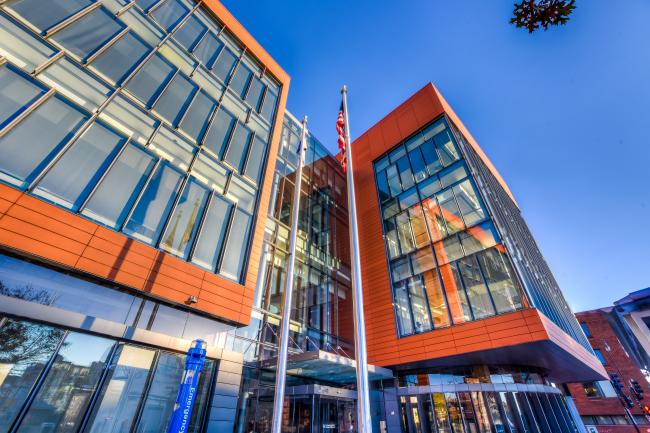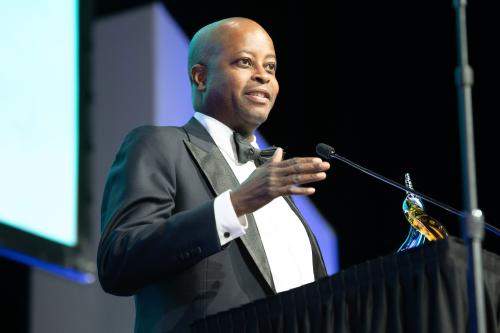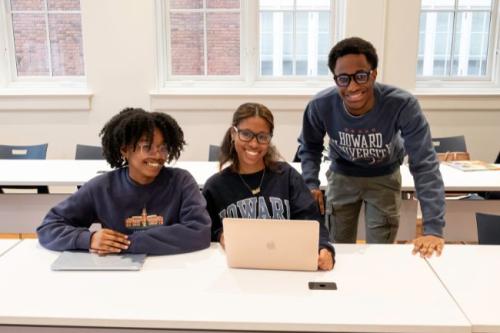With the announcement that the University will invest $785 million over the next five years to accelerate the Campus Master Plan through investments in new academic buildings, Howard is poised to take a giant leap forward as a leading institution of higher education. For the first time since 1984, Howard will be constructing new academic teaching centers on its campus. The majority of the funds ($670 million) will be used for the construction of new state-of-the-art multidisciplinary academic buildings, including the Health Sciences Complex, the Center for Arts and Communications, and the STEM Center. The remainder of the investment will go toward major renovations to existing facilities on campus, including the Myrtilla Miner Building, which will house the School of Education and the Howard University Middle School for Mathematics and Science. These new construction projects are slated to begin this year and are expected to be completed by 2026.
“This is a watershed moment in the history of our institution,” said Wayne A. I. Frederick, president of Howard University. “Thanks to the caliber of students we have enrolled, the illustrious faculty we have assembled, the dedicated staff we have hired, the committed alumni base we have cultivated, and the tremendously enhanced financial posture we have worked so hard to achieve, the state of the University has never been stronger. Now is the time for us to take decisive action for the future of our institution. We are poised to leverage the strength we possess in the present moment to solidify Howard’s status as one of the preeminent institutions of higher education in the country. The steps we are taking today will be validated by the world-changing work of our students, faculty and alumni and by the essential service Howard will provide to communities in need.”
How Did We Get Here? A Long-Term Roadmap to Transform the University.
The steps Howard is taking today are a result of actions and decisions the University made years before.
For financial and logistical reasons, the University cannot initiate all necessary and desired construction projects at the same time. When one building is under construction, the ability to use other buildings on campus becomes more essential, even if the buildings that are still in use themselves are in need of updates. In addition, an excess of construction projects can make for unpleasant studying conditions and disrupt essential work taking place across the campus. Furthermore, if the University were to overinvest in real estate at any one time it could take away resources from other areas of Howard’s operations, including student support services.
“Major construction initiatives on college and university campuses requires years of planning. We have to strategically prioritize which projects to undertake based on numerous factors, both internal and external. The fact that we are now positioned to move forward with three large-scale new construction efforts in addition to major renovations speaks volumes to the administration’s long-term vision and execution,” said Rashad Young, senior vice president and chief strategy officer. “These capital projects are going to dramatically accelerate our ability to achieve the goals we outlined in the strategic plan. With these new buildings, we will further enhance academic excellence, inspire new knowledge and serve the community.”
This latest investment represents the execution of the next phase of the administration’s plan to overhaul Howard’s real estate infrastructure. Over the last five years, the University has renovated 80 percent of residence halls with improved security and building system upgrades. The University Central Campus Master Plan also includes roughly 1,500 additional housing units.
Over the course of this next stage focused on the University’s academic spaces, Howard will undergo a transformation in order to offer students and faculty alike a tremendously enhanced academic and research experience.
Achieving Financial Sustainability
Many of the capital projects soon to be underway had been discussed, thought about and dreamed of for years by individuals on Howard’s campus. But one of the main reasons the University couldn’t move forward with them was because it just didn’t have the finances to do so.
Several recent factors and efforts have significantly improved the University’s financial outlook. Historic philanthropic investment in Howard, including MacKenzie Scott’s $40 million unrestricted donation to Howard in 2020, have infused unprecedented levels of funding into the University’s coffers. Additionally, Howard’s prudent financial management, despite the difficult conditions caused by the pandemic and the institution’s commitment to using its own funds to support faculty, students and staff throughout the crisis, have caused the University’s 2022 bond rating outlooks to improve from stable to positive.
Thanks to the improved bond ratings, Howard is now able to borrow capital at lower costs to the University. To fund these capital project investments, the University has just borrowed $300 million in 30-year fixed rate taxable bonds. The bottom line is that investors feel confident that investing in Howard University is a smart and reliable investment that would provide them a return on their investment.
“No matter how much philanthropic money the University could bring in, we knew that we would have to finance a significant portion of these major capital investments ourselves. Simply put, without the recent improved bond rating, we would not have been able to raise enough money for these projects,” said Stephen Graham, Howard’s chief financial officer. “Howard has always offered a top-of-the-line education. Our current financial position gives us the capability to build on and further that legacy as we solidify our stance as one of the most elite institutions in higher education.”
Cultivating a Contemporary, Cross-Disciplinary Education
The students and faculty of Howard University are national and international leaders and changemakers and they deserve facilities befitting of the change they will undoubtedly leave on the world. With this plan, Howard will deliver the facilities they so deserve. To provide students with a contemporary education, Howard is working to cultivate a multidisciplinary environment that fosters cross-cutting collaboration and groundbreaking partnerships. The new Health Sciences Complex will house the College of Medicine, College of Dentistry, College of Pharmacy and the College of Nursing and Allied Health Sciences; the Center for Arts and Communications will house the Chadwick A. Boseman College of Fine Arts and the Cathy Hughes School of Communications; and the STEM Center will house various STEM programs and disciplines, including physics, chemistry, biology, engineering, mathematics and associated labs. These new facilities are the culmination of the vision Howard has been working for years to realize.
“Howard’s current facilities for training medical students are over 80 years old,” said Dr. Hugh Mighty, Howard senior vice president of health and dean of the School of Medicine. “This new Health Sciences Complex facility will bring our methods of instruction into the 21st century and beyond by leveraging technology to make training and research more efficient and cutting edge.”
Throughout the history of our institution, Howard students and faculty have proven that they need very little to do a tremendous amount of good. But with the right environment, they can be empowered to do even more. Howard cannot just be an institution of higher education where students come to learn and faculty come to teach and conduct research in a single discipline. To truly be an institution of higher learning, Howard needs to empower our students and faculty to rise above their individual areas of study.





